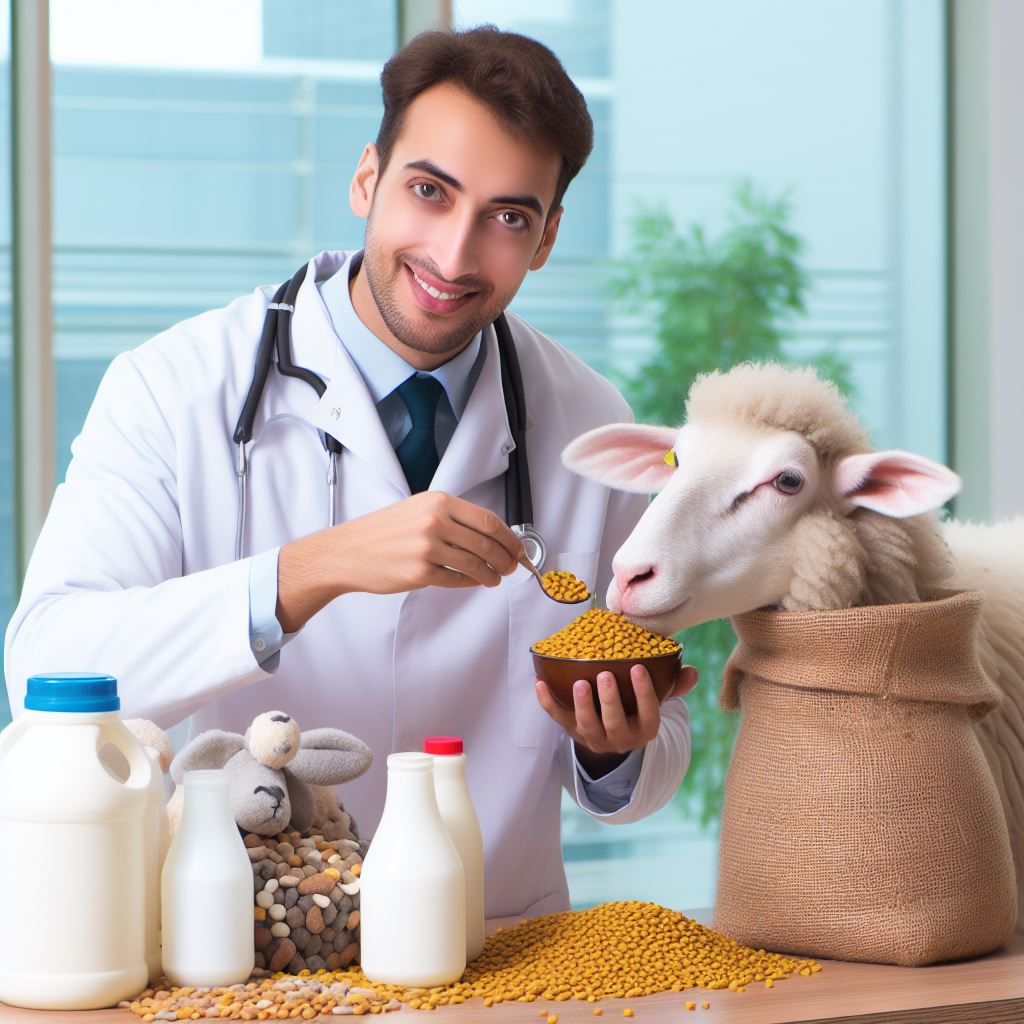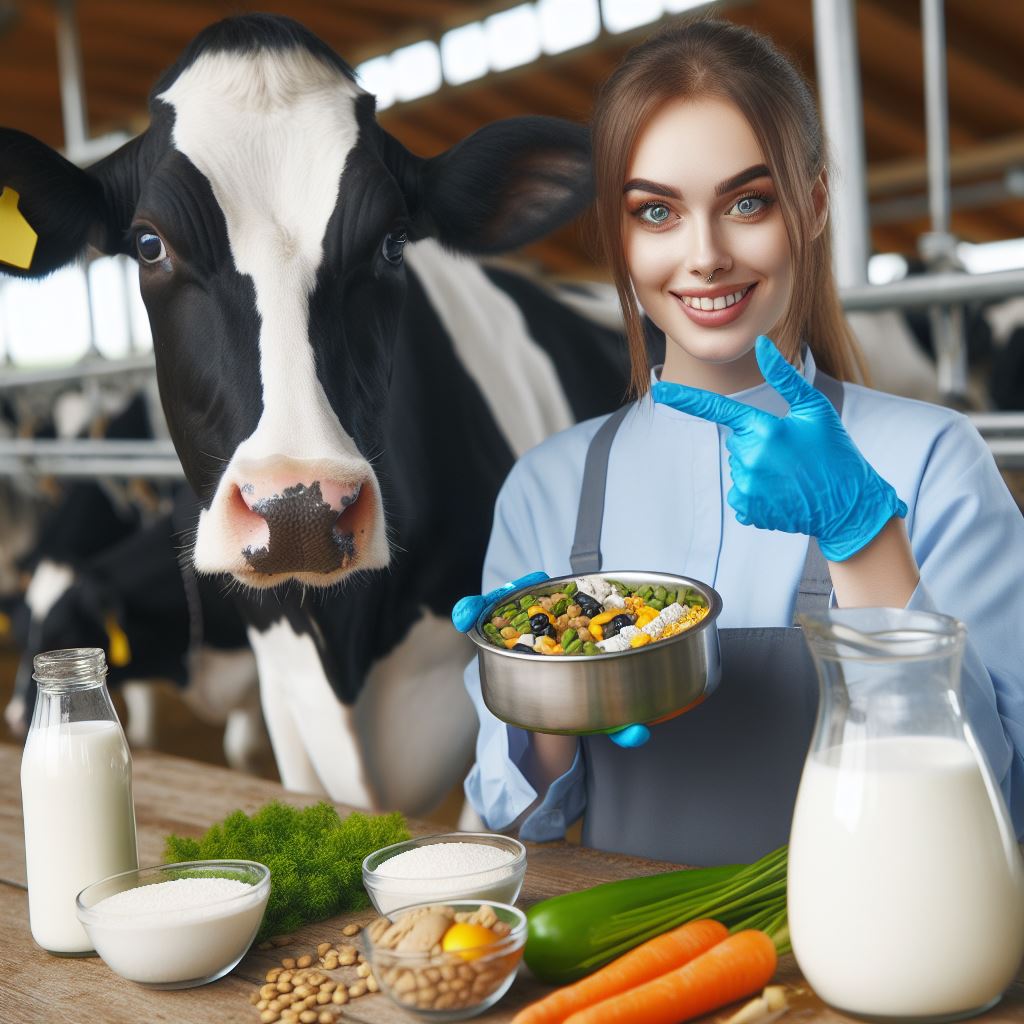Introduction
Effective breeding strategies play a crucial role in the beef production industry, ensuring optimal outcomes.
This blog post will provide an overview of the importance of such strategies and discuss key aspects related to beef breeding.
Effective breeding strategies are essential for beef producers as they directly impact the quality and productivity of the herd.
By selecting superior genetics, producers can improve important traits such as growth rate, feed efficiency, and carcass quality.
These strategies also help in maintaining genetic diversity and preventing inbreeding, thereby ensuring the long-term sustainability of the industry.
This blog post will delve into various aspects of effective breeding strategies for beef, including selection criteria, breeding methods, reproductive technologies, and the significance of record-keeping.
Each of these elements will be discussed in detail, providing valuable insights for beef producers who aim to enhance their breeding programs.
Selection criteria will cover factors like breed suitability, desired traits, and performance data analysis.
Breeding methods will outline natural breeding, artificial insemination, and embryo transfer, highlighting their advantages and limitations.
Reproductive technologies will include topics such as estrus synchronization, pregnancy diagnosis, and genetic testing.
Lastly, this post emphasizes the significance of record-keeping in breeding strategies.
Accurate and organized records help in tracking individual animal performance, identifying superior genetics, and making informed breeding decisions.
By exploring these key aspects, this blog post aims to equip beef producers with the knowledge required to implement effective breeding strategies, ultimately leading to improved productivity and profitability in the industry.
Understanding the Basics of Beef Breeding
Explanation of breeding goals and objectives
Breeding is a crucial aspect of beef production as it directly affects the quality and characteristics of the beef.
It is essential to establish clear breeding goals and objectives to ensure the desired outcomes.
Transform Your Agribusiness
Unlock your farm's potential with expert advice tailored to your needs. Get actionable steps that drive real results.
Get Started- Improving meat quality: One of the primary breeding goals is to enhance the meat quality, including tenderness, marbling, flavor, and juiciness. This can be achieved by focusing on selecting breeds with superior meat traits and utilizing appropriate genetic selection tools.
- Enhancing growth and feed efficiency: Another important objective is to increase the growth rate and feed efficiency of beef cattle. This can be accomplished by selecting breeds known for their rapid growth and ability to convert feed into muscle efficiently.
- Health and disease resistance: Breeding for improved health and disease resistance is crucial to reduce the incidence of common illnesses and minimize the need for veterinary interventions. Traits such as resistance to parasites, adaptability to specific environments, and overall robustness should be considered.
- Maternal characteristics: Breeding goals should also include traits that ensure successful reproduction and maternal instincts in cows. These traits can include fertility, ease of calving, milk production, and mothering ability. It is essential to prioritize breeds known for these characteristics.
Selection of suitable breeds for specific objectives
Selecting suitable breeds is a critical step in developing effective breeding strategies for beef production.
Different breeds possess distinct characteristics that can be advantageous for specific objectives.
- British Breeds: British breeds such as Angus, Hereford, and Shorthorn are well-known for their excellent meat quality. They have high marbling, which contributes to superior beef tenderness and flavor. These breeds are often preferred for producing high-quality, premium beef.
- Continental Breeds: Continental breeds like Charolais, Limousin, and Simmental are renowned for their exceptional growth rate and muscling. They have superior feed efficiency and can produce cattle with high carcass weights. These breeds are often utilized for commercial beef production.
- Dual-Purpose Breeds: Some breeds, like Red Poll and Devon, are known for their dual-purpose capabilities. They offer a balance between meat production and milk production. These breeds are often chosen for small-scale farming operations that require both beef and dairy products.
Genetic considerations in beef breeding
Understanding the genetic aspects of beef breeding is crucial to achieve successful outcomes and ensure long-term sustainability in the industry.
- Breed composition and crossbreeding: Breed composition plays a significant role in determining the performance of beef cattle. Crossbreeding can be employed to capitalize on the desirable traits of different breeds and achieve heterosis, resulting in improved performance and productivity.
- Genetic selection tools: Genetic selection tools, such as Expected Progeny Differences (EPDs), allow breeders to estimate the genetic potential of an individual animal for specific traits. These tools provide valuable information to make informed breeding decisions and select superior breeding stock.
- Genetic diversity: Maintaining genetic diversity is vital to prevent inbreeding depression and preserve the overall health and adaptability of beef cattle populations. Breeders should prioritize genetic diversity to minimize the risk of genetic disorders and improve overall resilience.
- Consideration of market demands: Breeding strategies should also account for market demands, consumer preferences, and industry trends. Maximizing profitability requires aligning breeding goals with market expectations, such as producing beef with specific attributes favored by consumers.
In short, understanding the basics of beef breeding is essential to develop effective breeding strategies.
Breeding goals and objectives should be established, suitable breeds selected, and genetic considerations carefully evaluated.
By applying these principles, beef producers can optimize meat quality, growth, and overall productivity, ensuring a thriving beef industry.
Read: Cattle Welfare: Ensuring Healthy Lives
Evaluating Breeding Stock
Importance of selecting high-quality breeding stock
Selecting high-quality breeding stock is crucial for effective beef breeding strategies.
To begin with, high-quality breeding stock ensures the production of offspring with desirable traits.
Good quality genetics contribute to the overall success and profitability of the beef operation.
It also helps in maintaining breed standards and improving the overall breed over time.
Assessing genetic potential and performance records
Assessing the genetic potential of breeding stock is essential for making informed decisions.
By analyzing performance records, breeders can evaluate the animal’s growth rate, carcass characteristics, and other important traits.
Genetic potential refers to the animal’s ability to pass on desirable traits to its offspring.
This evaluation helps in selecting animals that will improve the herd’s productivity and profitability.
Examining phenotypic traits and structural soundness
Besides genetic potential, evaluating phenotypic traits is equally important in breeding stock selection.
Phenotypic traits include physical characteristics such as body structure, muscle development, and overall appearance.
These traits can indicate an animal’s ability to thrive in the beef production system.
Structural soundness, which includes proper skeletal structure and sound feet and legs, is crucial for longevity and productivity.
Utilizing reproductive soundness evaluations
- One critical aspect of breeding stock evaluation is reproductive soundness evaluations.
- Reproductive soundness evaluations assess the animal’s ability to breed and produce healthy offspring.
- Breeding stock should undergo reproductive evaluations, including assessing reproductive organs, semen quality, and pregnancy rates.
- This evaluation ensures that only reproductively sound animals are utilized for breeding, avoiding future breeding challenges.
In summary, evaluating breeding stock is a crucial step in effective beef breeding strategies.
Selecting high-quality breeding stock based on genetic potential, performance records, phenotypic traits, and reproductive soundness is key.
Doing so ensures the production of offspring with desirable traits, maintains breed standards, and improves overall herd productivity and profitability.
Read: Beef Cattle Nutrition: What Works Best?
Utilizing Artificial Insemination (AI) Techniques
Advantages and disadvantages of AI in beef breeding
Advantages of AI in beef breeding
- Increases genetic improvement by using superior sires
- Allows access to high-quality genetics without the need to maintain a bull
- Reduces the risk of introducing diseases or injuries associated with natural mating
- Provides the opportunity for more precise breeding management
- Enables the use of sexed semen to target specific gender offspring
Disadvantages of AI in beef breeding
- Requires skilled technicians for proper semen handling and insemination
- Initial setup costs can be relatively high, including semen storage and handling equipment
- Success rates can vary depending on the expertise of the inseminator and the quality of the semen used
- Timing is crucial, and missed heat cycles can result in lower conception rates
- Regular heat detection and synchronization protocols are necessary for effective AI programs
Selecting the right sires for AI programs
Determine the breeding goals and priorities
- Identify the traits and characteristics that are important for your specific beef operation
- Consider factors such as growth rate, carcass quality, maternal traits, and disease resistance
- Research and select sires that excel in the desired traits and have proven track records
Evaluate genetic data and EPDs (Expected Progeny Differences)
- Review the available data on sires’ performance and EPDs for relevant traits
- Look for sires with favorable EPDs that align with your breeding goals
- Consider the reliability of EPDs and choose sires with higher accuracy values
Proper AI protocol and timing considerations
Heat detection and synchronization
- Implement a consistent heat detection program to accurately identify females in estrus
- Utilize methods such as tail chalk, heat patches, or electronic heat detection systems
- Consider using synchronization protocols to align heat cycles and optimize breeding efficiency
Semen handling and insemination
- Ensure proper storage and handling of semen to maintain its viability and fertility
- Thaw semen following the recommended protocols to avoid damaging the sperm cells
- Perform AI procedures using clean and sanitized equipment to minimize the risk of infections
Managing AI success rates and pregnancy rates
Monitor and evaluate success rates
- Keep track of the number of inseminations performed and the resulting pregnancies
- Analyze any fluctuations or trends in success rates to identify potential issues
- Identify and address factors that may contribute to lower success rates, such as technician proficiency or semen quality
Optimize nutrition and herd health
- Provide optimal nutrition to enhance reproductive performance of the females
- Implement a herd health program to prevent and treat any reproductive disorders or diseases
- Consult with a veterinarian to establish a proper vaccination and deworming schedule
Implement proper record keeping
- Maintain accurate records of breeding dates, AI protocols, and pregnancy outcomes
- Track the performance of individual animals to make informed breeding decisions in the future
By utilizing artificial insemination techniques effectively, beef producers can improve genetic outcomes, enhance breeding management, and optimize overall herd performance.
Showcase Your Farming Business
Publish your professional farming services profile on our blog for a one-time fee of $200 and reach a dedicated audience of farmers and agribusiness owners.
Publish Your ProfileRead: Innovations in Dairy Cattle Management
Implementing Controlled Breeding Seasons
Benefits of controlled breeding seasons in beef production
- Improved genetic control
- More uniform calf crop
- Better management of resources
- Easier identification of problem breeders
Determining the optimal length of the breeding season
- Consider factors like bull-to-cow ratio, age of cows, and available resources
- Shorter breeding season leads to more uniform calves and easier management
- Longer breeding season allows for more flexibility but may result in less uniformity
Strategies for synchronization of estrus and ovulation
- Use hormone treatments to synchronize estrus in a group of cows
- Options include fixed time AI, timed artificial insemination, or hormonal implants
- Consult with a veterinarian to determine the most appropriate method for your herd
Managing calving intervals and herd efficiency
- Aim for a 365-day calving interval to maximize herd productivity
- Implement proper nutrition and health programs to optimize reproduction
- Regularly monitor body condition score and adjust feeding strategies accordingly
- Consider culling non-productive or problem cows to improve overall herd efficiency
In closing, implementing controlled breeding seasons in beef production brings numerous benefits, including improved genetic control, more uniform calf crop, better resource management, and easier identification of problem breeders.
Determining the optimal length of the breeding season requires careful consideration of factors such as bull-to-cow ratio, age of cows, and available resources.
Synchronization of estrus and ovulation can be achieved through the use of hormone treatments, and consulting with a veterinarian is recommended to determine the most suitable method for your herd.
Efficient management of calving intervals and overall herd efficiency can be achieved by aiming for a 365-day calving interval, providing proper nutrition and health programs, and regularly monitoring body condition score.
It is also important to consider culling non-productive or problem cows to improve herd productivity.
By implementing these strategies, beef producers can enhance their breeding programs and ultimately optimize their operations.
Read: Managing Cattle: Disease Prevention Tips

Considerations for Crossbreeding Programs
Advantages of crossbreeding in beef production
The positive outcomes resulting from prioritizing cattle welfare extend beyond the animals themselves.
Farms that prioritize welfare observe healthier and more productive animals.
Better welfare practices also minimize disease outbreaks, reducing the need for antibiotics and creating a more sustainable farming system.
Cattle raised in environments that prioritize welfare exhibit reduced stress levels and improved behavior.
This not only contributes to their own well-being but also makes handling and management tasks easier and safer for farmers.
As a result, farmers who implement best practices experience increased job satisfaction and a sense of pride in their work.
Furthermore, improved welfare practices often translate into better quality beef and dairy products.
Cattle that are raised in welfare-centric environments produce superior meat and milk, leading to greater customer satisfaction and loyalty.
This ultimately benefits the farmers by establishing a positive reputation and increasing market demand for their products.
Crossbreeding offers numerous advantages in beef production that can significantly improve overall profitability
- Increased hybrid vigor: Crossbred animals typically exhibit enhanced performance traits due to heterosis, resulting in higher growth rates, improved fertility, and better disease resistance.
- Genetic diversity: By combining different breeds, crossbreeding introduces a wider genetic pool, reducing the risk of inheriting genetic disorders and increasing adaptability to various environments.
- Improved carcass quality: Some crossbred combinations yield animals with superior meat quality attributes, such as tenderness, marbling, and flavor, appealing to consumers and commanding premium prices.
- Market versatility: Crossbred animals can possess desirable traits from multiple breeds, allowing producers to target diverse market segments and cater to specific consumer demands.
- Enhanced reproductive efficiency: Crossbreeding can address fertility issues and reproductive inefficiencies associated with inbreeding, resulting in higher conception rates and reduced calving difficulties.
Selecting appropriate breeds for crossbreeding
Choosing the right breeds for crossbreeding is crucial to maximize the benefits and achieve desired production goals.
- Complementary breed traits: Select breeds with complementary characteristics, combining traits such as maternal ability, growth performance, adaptability, and carcass quality to achieve desired outcomes.
- Suitability to environment: Consider the climate, forage availability, and environmental challenges specific to the production system when selecting breeds that can thrive and exhibit optimal performance in those conditions.
- Market demands: Identify the target market’s preferences and requirements, focusing on breeds that can deliver desired carcass traits and meat quality attributes to fulfill consumer expectations.
- Breed compatibility: Ensure chosen breeds have compatible breeding systems, including similar calving seasons, breeding cycles, and reproductive performance, to facilitate efficient management practices.
Designing effective crossbreeding systems
Careful planning and systematic implementation are essential in designing crossbreeding systems for maximum success.
- Establish breeding objectives: Clearly define specific production goals, such as improving growth rates, maternal abilities, or carcass characteristics, to guide breed selection and mating strategies.
- Create breeding rotations: Develop strategic breeding rotations by utilizing a combination of different breed crosses in successive generations to maintain hybrid vigor and continually improve desired traits.
- Implement rotational or terminal crossbreeding: Decide whether to utilize rotational crossbreeding systems, where crossbred females are retained for breeding, or terminal crossbreeding systems, where crossbred animals are solely bred for market purposes.
- Monitor and evaluate performance: Regularly assess the performance of crossbred animals, focusing on traits of interest, such as growth rates, fertility rates, and carcass quality, to make informed selection decisions and adjustments to the breeding program.
Managing hybrid vigor and breed complementarity
To effectively manage hybrid vigor and breed complementarity, certain considerations need to be addressed.
- Balance of breed contributions: Maintain a balance between breed contributions within the crossbred population to ensure desired traits are maintained and prevent excessive dilution of favorable characteristics.
- Replacement females: Pay close attention to selecting suitable replacement females from crossbreeding programs, as they may exhibit varying levels of hybrid vigor and breed complementarity, influencing overall herd performance.
- Genetic selection and mating strategies: Continuously assess and select animals that exhibit desirable traits, including breed complementarity and hybrid vigor, to retain within the breeding system and enhance future generations.
- Avoid excessive inbreeding: Limit inbreeding in crossbreeding programs to prevent negative impacts on fertility, performance, and overall animal health.
Therefore, incorporating crossbreeding strategies in beef production can bring significant advantages.
Careful selection of appropriate breeds, thoughtful design of breeding systems, and effective management of hybrid vigor and breed complementarity are key to maximizing the benefits and ensuring long-term success.
Incorporating Genomic Selection Tools
Role of genomics in beef breeding strategies
Genomics plays a crucial role in modern beef breeding strategies to enhance genetic progress.
It allows breeders to identify superior animals based on their DNA profiles.
Genomic selection helps breeders understand the genetic potential of individuals more accurately than traditional methods.
It enables breeders to select animals with desirable traits for improved beef production, such as disease resistance, feed efficiency, and carcass quality.
By incorporating genomics, breeders can accelerate the genetic improvement of beef cattle, ultimately increasing profitability and sustainability.
Understanding genomic estimated breeding values (GEBVs)
Genomic estimated breeding values (GEBVs) provide a quantifiable estimate of an animal’s genetic merit using genomic data.
GEBVs enable breeders to evaluate an animal’s traits, such as growth rate, milk production, and meat quality, more accurately.
These values are calculated by comparing an animal’s DNA markers to reference populations with known performance and genetic information.
By using GEBVs, breeders can identify animals with the highest breeding values for specific traits, thus making more informed selection decisions.
Utilizing DNA testing for selection decisions
DNA testing is an essential tool in modern beef breeding strategies, offering insights into an animal’s genetic potential.
It allows breeders to identify animals carrying specific genes related to desirable traits, such as marbling or tenderness.
DNA testing also helps in identifying animals carrying harmful genetic mutations, preventing their inclusion in the breeding program.
By using DNA testing, breeders can make more informed selection decisions and avoid potential losses due to genetic disorders.
Integrating genomics with traditional breeding techniques
- Integrating genomics with traditional breeding techniques enhances the efficiency and effectiveness of beef breeding programs.
- Genomic information can be used in conjunction with pedigree and performance data to improve selection accuracy.
- By combining both approaches, breeders can identify animals with superior traits more confidently and reduce the generation interval.
- Using genomics alongside traditional breeding practices allows for a more comprehensive understanding of an animal’s genetic profile.
- This integration accelerates the genetic progress of beef cattle and ensures the production of superior animals for future generations.
All in all, incorporating genomic selection tools is crucial for effective beef breeding strategies.
Genomics provides valuable insights into an animal’s genetic potential, allowing breeders to select animals with superior traits accurately.
By utilizing genomic estimated breeding values (GEBVs) and DNA testing, breeders can make more informed selection decisions and avoid potential losses.
Furthermore, integrating genomics with traditional breeding techniques optimizes the efficiency and effectiveness of beef breeding programs, ultimately leading to genetic progress and improved profitability.
Find Out More: Sustainable Livestock Watering
Showcase Your Farming Business
Publish your professional farming services profile on our blog for a one-time fee of $200 and reach a dedicated audience of farmers and agribusiness owners.
Publish Your ProfileEnhancing Reproductive Health and Fertility
Enhancing reproductive health and fertility is essential for the success of beef breeding operations.
Importance of proper nutrition for reproductive success
- Providing a balanced diet with adequate levels of protein, minerals, and vitamins is crucial.
- These nutrients support optimal reproductive development and function.
- Consult with a nutritionist to ensure the diet meets the specific needs of breeding cattle.
- Inadequate nutrition can lead to delayed puberty, increased calving intervals, and reduced conception rates.
Managing reproductive diseases and disorders
- Regularly monitor the herd for signs of reproductive diseases such as brucellosis and trichomoniasis.
- Quarantine and treat affected animals promptly to prevent the spread of infections.
- Vaccinate the herd against common reproductive diseases to minimize the risk of outbreaks.
- Conduct regular fertility exams and consult with a veterinarian to identify and address any reproductive disorders.
Implementing effective herd health programs
- Develop a comprehensive herd health program in collaboration with a veterinarian.
- This program should include vaccinations, parasite control, and regular health check-ups.
- Healthy cows have a higher chance of successful breeding and maintaining reproductive health.
- Regularly review and update the herd health program to address emerging health issues.
Addressing fertility challenges and optimizing reproductive performance
- Monitor the reproductive performance of individual cows through careful record-keeping.
- Identify animals with low fertility rates and investigate potential causes.
- Evaluate breeding methods and consider different strategies such as artificial insemination or natural service.
- Implement proper heat detection techniques to ensure optimal timing for breeding.
- Manage bull fertility by conducting regular examinations and semen quality assessments.
- Implement effective estrus synchronization protocols to maximize breeding success.
By implementing these strategies, beef producers can enhance reproductive health and fertility in their herds, leading to improved breeding success and overall profitability.
Uncover the Details: Latest Milking Tech: Revolutionizing Dairy Farms
Find Out More: Eco Duck Rearing Principles
Conclusion
Throughout this blog post, we have explored a range of effective breeding strategies for beef production.
We have learned about the importance of selecting superior genetics and optimizing breeding practices.
By implementing measures such as artificial insemination, genetic testing, and careful sire selection, beef producers can significantly improve the quality and productivity of their herds.
Effective breeding strategies play a crucial role in the success of beef production.
They not only enhance the overall genetic potential of the herd but also improve important traits such as growth rate, carcass quality, and disease resistance.
By harnessing the power of genetics, producers can ensure that their cattle meet market demands, resulting in higher profitability and customer satisfaction.
Incorporating effective breeding strategies into your beef production operations can lead to improved profitability and sustainability in the long run.
Embrace technologies and tools that are readily available, and strive to continually enhance your breeding program.
Remember, successful breeding is a continual process of improvement.
Stay updated with the latest research and industry trends to ensure that you are maximizing the potential of your herd.
Implement these strategies, and watch as your beef production operation thrives, ensuring a secure and prosperous future.




